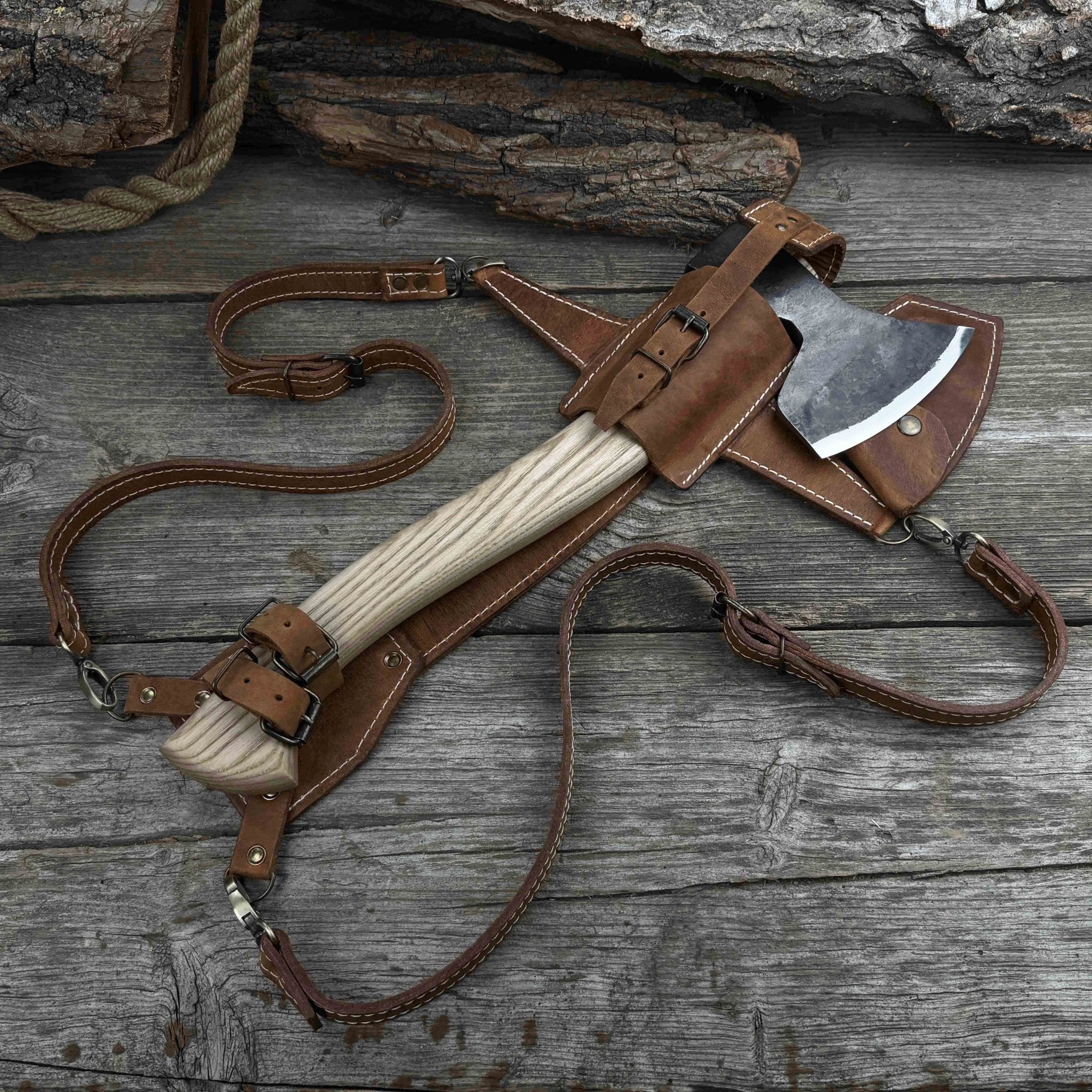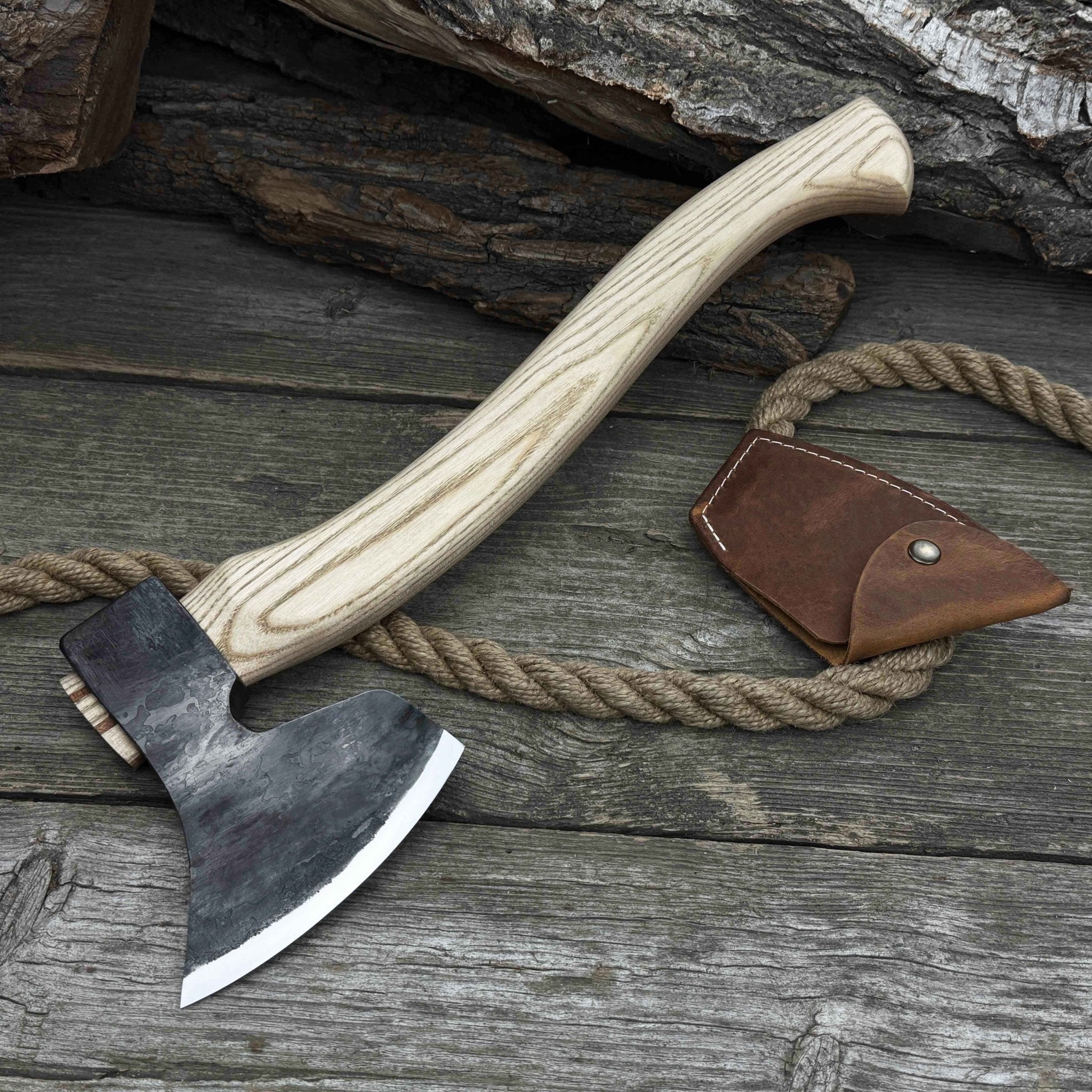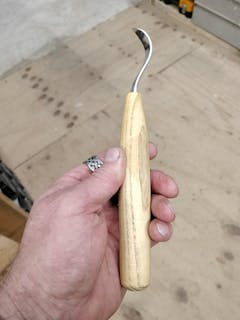Hand-Forged Carving Axe, 1.05 kg (2.31 Ib)
Small Carving Axe, 0.66 kg (1.46 lb)
Small Carving Axe, 0.7 kg (1.54 lb)
What is a Carpenter's Axe?
A carpenter’s axe, also referred to as a carpenter’s hatchet, is a specialized tool for precise woodworking tasks. It is slightly larger than a hatchet and features a straight, long handle and a straight cutting edge. Unlike general-purpose axes, carpentry axe has a pronounced beard and a finger notch, allowing for a choked grip necessary for precise control over the blade. Its unique balance and functionality sets it apart from other axes:
- Blade: The carpenter axe has a wide, straight-edged blade with a slight bevel on one side for more controlled, flat cuts against the wood grain. The blade is usually thinner than those of other axes. The choked grip of the carpenter hatchet differentiates it from others, allowing for better control during fine work.
- Weight: The weight of carpenter’s axes usually ranges from 1.5 to 2.5 pounds (0.7 to 1.1 kg). It is lighter than a splitting or felling axe but heavier than a hatchet. This lighter weight, combined with a balanced design, allows for extended use when working on joinery or planing wood.
- Handle: The length of the handle is usually shorter than that of other axes, ranging from 14 to 20 inches (35 to 50 cm). This shorter length and straight shape enhance maneuverability, as a wood worker can hold the wood axe closer to the blade.
Now, let’s take a closer look at how a carpenter's hatchet compares to a hatchet, wood chopping axe, rigging axe, splitting axe and felling axe.
Hatchet
Intended use: A versatile tool for light chopping, splitting, and small outdoor tasks.
Size: Features a narrower blade and is lighter than a carpentry axe.
Distinct feature: Has a more convex edge for general chopping rather than a straight or single bevel edge.
Chopping axe
Intended use: Designed for general chopping tasks like breaking down branches or cutting firewood.
Size: Has a heavier head for deeper cuts but is similar in size to a carpenters axe.
Distinct feature: Features a convex edge that is more durable but less suited for precision work.
Rigging axe
Intended use: Used in logging and construction for heavy-duty tasks.
Size: The handle of a rigging axe is typically longer for more forceful swings.
Distinct feature: Often includes a hammerhead on the back for driving nails and spikes, with a blade designed for chopping and cutting tasks on the job site.
Splitting axe
Intended use: This professional axe is designed specifically for splitting wood along the grain.
Size: Often features longer handles for better leverage and brute force.
Distinct feature: The blade is much wider and more wedge-shaped, allowing it to split wood rather than slice. The heavier blade helps split wood fibers.
Felling axe
Intended use: Used to cut down trees by slicing across the grain.
Size: Has a longer handle for more leverage and is generally larger than a carpenters hatchet.
Distinct feature: Its blade is thin, sharp, and often double-beveled to ensure clean cuts.
Types of Carpenter’s Axes in Our Collection
Sharky Forged Steel Tools™ offers a diverse range of axe sizes and shapes to cater to various woodworking tasks. Each carpenter’s axe is hand-forged from high-quality 52100 carbon steel with a hardness of 59/62 HRC. This ensures a sharp edge for a long time. The ergonomic handles are crafted from ash wood, known for its resistance to shock and lightweight properties. The carpenter's axes come with leather cases and are pre-sharpened for immediate use. Here are some of our offerings:
Hand-Forged Carving Axe
Weight: 1.05 kg (2.31 lb)
Handle Length: 40 cm (15.75 inches)
Head Length: 17.5 cm (6.89 inches)
This carpenter hatchet is perfect for precision carving, shaping small pieces of wood, and fine woodworking tasks. This axe is manageable with one hand and useful for bushcraft tasks like creating camp utensils and tent pegs.
27.5" Hand-Forged Wood Chopping Axe
Weight: 2.1 kg (4.5 lb)
Handle Length: 71 cm (27.95 inches)
Head Length: 17.5 cm (6.89 inches)
Designed for heavy-duty chopping, this axe is ideal for cutting logs and branches, splitting wood for kindling or fence posts, and hewing logs for beams and planks. It is also excellent for prepping wood for finer work.
Hand-Forged Small Carving Axe
Weight: 0.66 kg (1.46 lb) & 0.7 kg (1.54 lb)
Handle Length: 30.5 cm (12.01 inches)
Head Length: 13.5 cm (5.31 inches)
This lightweight carpenter axe can handle intricate carving and small-scale projects. It is ideal for shaping handles, spoons, bowls, and other detailed objects.
Proper Use and Maintenance of Carpenter's Axes
A well-maintained carpentry axe provides better performance, while using it correctly prevents accidents and injuries. Here are a few basic recommendations:
Safe Handling Tips
- Foot Position: For right-handed wood workers, the left foot should be forward with the right foot back, providing a stable, braced stance. This foot placement also keeps the body behind the carpenter’s axe, allowing for controlled force.
- Bending from the Hips: A slight forward tilt from the hips, rather than bending from the knees, provides balance, a clear line of sight, and leverage without straining the lower back.
- Avoiding a “Death Grip”: Many people grip too tightly, fearing a slip, but a loose grip lets carpenter's axes work more naturally. Hold the axe lightly and focus on directing it toward the block or chop surface below.
- Targeting the Block Below the Wood: Visualizing cutting through the wood into the block below results in smoother, safer swings.
- Using Gravity: Let the weight of the carpentry axe fall naturally, using the axe’s weight as the main force.
- Maintain a Proper Cutting Angle: Aim to strike wood at around a 45-degree angle to reduce the effort needed to cut logs.
Best Maintenance Practices
All you need is a small pocket stone and some honing oil or water to sharpen the carpentry axe blade:
- Secure the Axe: Place it on a flat surface and use two pieces of wood to secure it: one at the back of the axe, secured with two screws, and the other on the opposite side.
- Apply Oil or Water: Apply a few drops of honing oil or water to a pocket stone to reduce friction.
- Maintain the Right Angle: Keep a consistent angle (20 degrees) during sharpening.
- Sharpen the Edge: Move the stone in circular motions along the axe edge. Focus on the last millimeters where sharpness is most crucial.
- Check for Burr: A burr on the opposite edge indicates sufficient sharpening.
- Switch Sides: Once a burr forms, switch to the other edge side.
- Hone the Edge: Use the fine side of the pocket stone to hone the edge and remove burrs.
- Clean the Axe and Prevent Rust: Wipe the carpentry axe head with a clean cloth. Apply a thin layer of oil to the axe head and remove excess oil. Take good care of the axe’s handle by applying boiled linseed oil to it.
Safe and Effective Use
- Clearing Space: Remove obstacles from the workspace to prevent tripping or accidents.
- Straight Swings Matter: Vertical swings minimize unintended rebounds, as the carpenter’s axe travels on a predictable, downward path. This is especially useful if the axe misses or the wood splits differently than expected.
- Adjust the Wood, Not the Axe: For an angled cut, adjust the wood, not the axe, which maintains the safety of a vertical swing.
- Breaking the Grain: If the axe binds in the wood, break the grain by lifting the wood and tapping it on the block instead of forcefully pulling.
Conclusion
In summary, using carpenter's axes effectively involves maintaining a steady tempo for smoother and more controlled carving and cuts. Practice multiple techniques, including the 'guillotine' method—using the axe’s heel or toe on the wood and pressing with body weight. Regularly inspect the axe and keep it in good condition to extend its efficiency and improve your woodworking skills.














